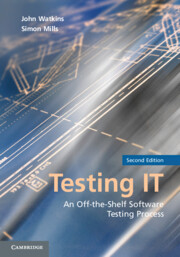Book contents
- Frontmatter
- Contents
- Foreword to the Second Edition by Geoff Thompson
- Foreword to the First Edition by Maurice Rosenburgh
- Acknowledgments
- 1 Introduction
- PART 1 THE TRADITIONAL TESTING PROCESS
- 2 An Overview of Testing
- 3 Testing Techniques
- 4 The Management and Planning of Testing
- 5 Unit Testing
- 6 Integration Testing
- 7 System Testing
- 8 Systems Integration Testing
- 9 User Acceptance Testing
- 10 Operations Acceptance Testing
- 11 Regression Testing
- 12 Improving the Testing Process
- 13 Introduction, Adoption, and Maintenance of the Testing Process
- 14 Agile Testing
- PART 2 THE TESTING PROCESS IN THE REAL WORLD: ILLUSTRATIVE CASE STUDIES
- PART 3 THE APPENDICES
- References
- Glossary
- Index
4 - The Management and Planning of Testing
Published online by Cambridge University Press: 03 May 2011
- Frontmatter
- Contents
- Foreword to the Second Edition by Geoff Thompson
- Foreword to the First Edition by Maurice Rosenburgh
- Acknowledgments
- 1 Introduction
- PART 1 THE TRADITIONAL TESTING PROCESS
- 2 An Overview of Testing
- 3 Testing Techniques
- 4 The Management and Planning of Testing
- 5 Unit Testing
- 6 Integration Testing
- 7 System Testing
- 8 Systems Integration Testing
- 9 User Acceptance Testing
- 10 Operations Acceptance Testing
- 11 Regression Testing
- 12 Improving the Testing Process
- 13 Introduction, Adoption, and Maintenance of the Testing Process
- 14 Agile Testing
- PART 2 THE TESTING PROCESS IN THE REAL WORLD: ILLUSTRATIVE CASE STUDIES
- PART 3 THE APPENDICES
- References
- Glossary
- Index
Summary
“Plans are worthless, the process of planning is invaluable”
– EisenhowerIntroduction
This chapter deals with the issues associated with the organization, management, and high-level planning of the testing process.
A generic approach to organizing the testing process is described, which can be applied to businesses involved in developing and/or testing software. The chapter discusses the implications for the testing process of the size of the business, its prevailing quality culture, and (where appropriate) the maturity of its software development process.
The case studies in Part 2 of this book provide specific examples of how a number of different businesses have customized this generic approach in response to their own particular organizational, management, and testing requirements.
This chapter also considers a number of key requirements that must be considered in implementing a rigorous, effective, and efficient testing process: the need for configuration management, defect tracking, and the need to ensure that each of the requirements of the application under test (AUT) has been verified. The issues associated with each of these requirements are discussed, and recommendations for supporting them are provided.
The chapter concludes with a discussion of the role of risk-based testing and its use in the management and planning of testing projects.
- Type
- Chapter
- Information
- Testing ITAn Off-the-Shelf Software Testing Process, pp. 30 - 47Publisher: Cambridge University PressPrint publication year: 2010



